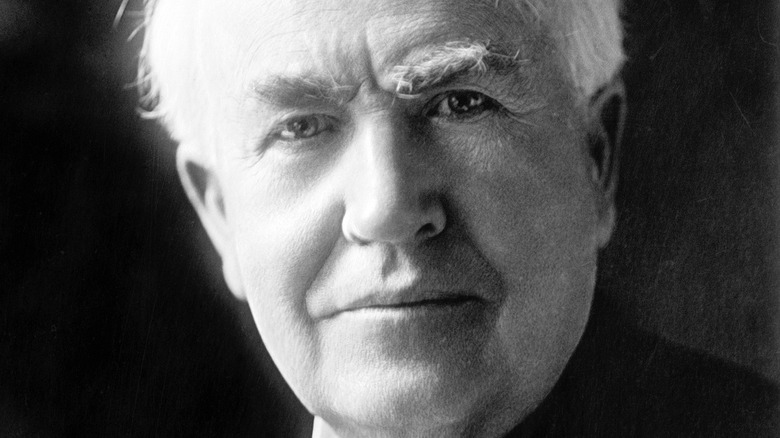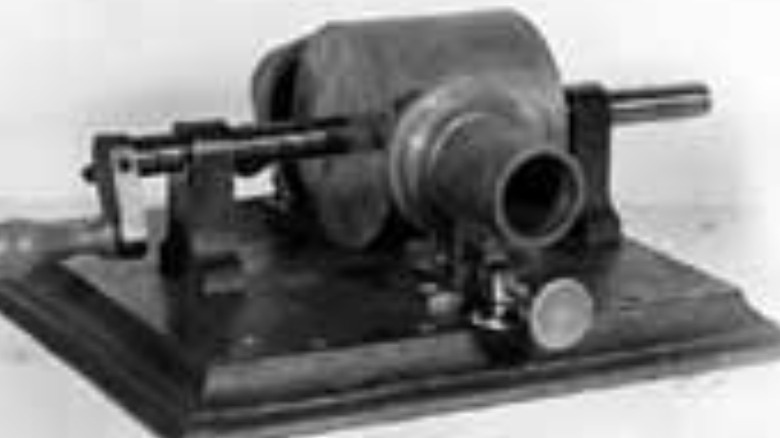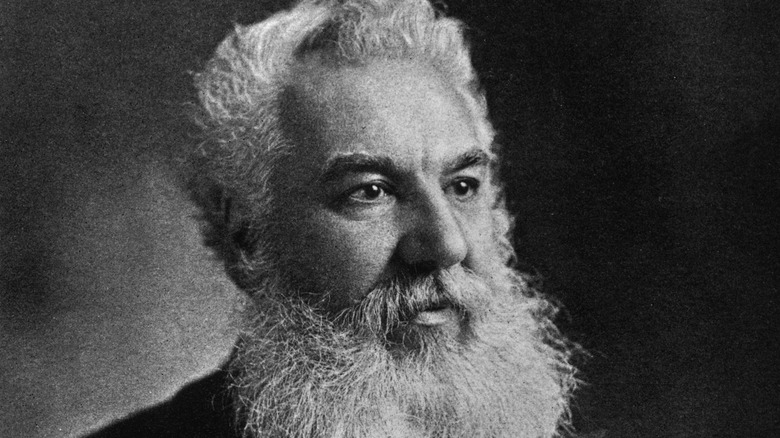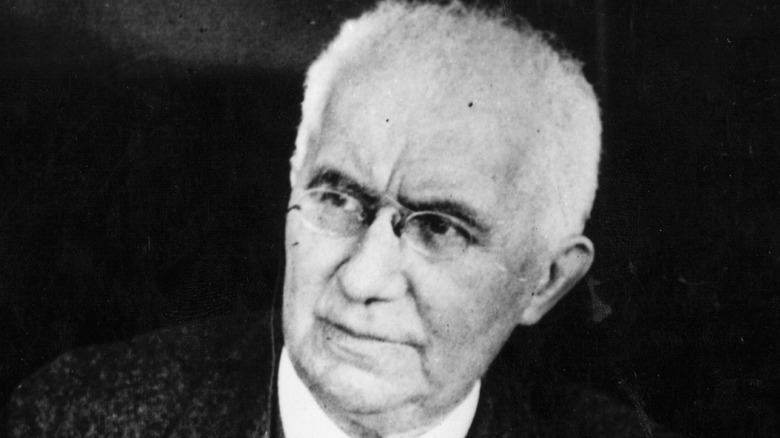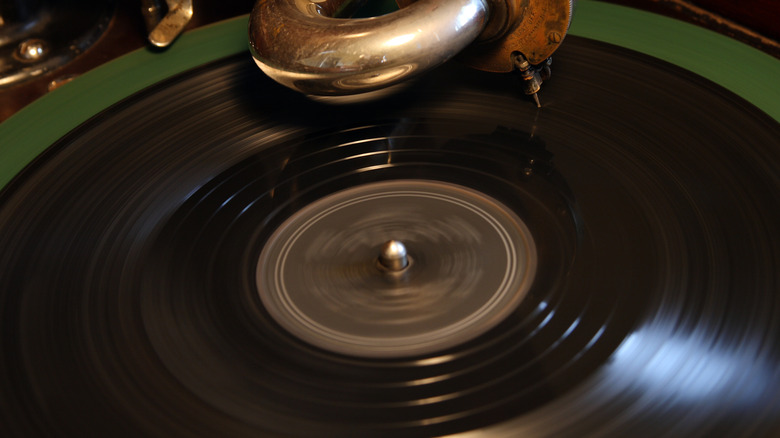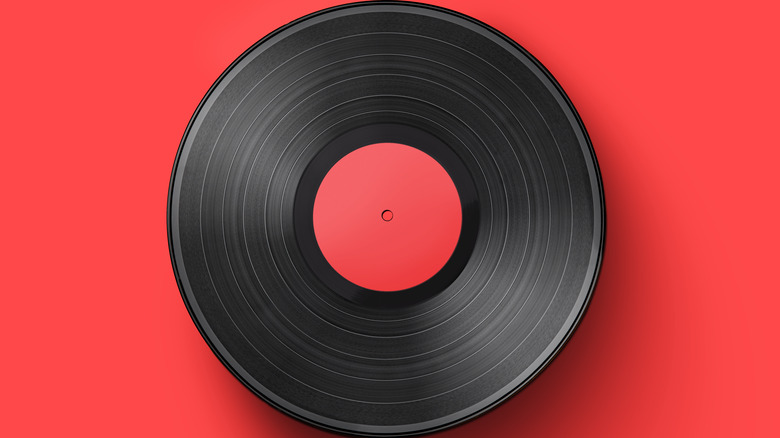What Came First, The Record Player Or Records?
It may come as a surprise, but the first record players did not have any records at all. The popular music-playing device was developed out of an invention by Thomas Edison. Edison was working on a way to preserve messages sent via telegraph by indenting them on paper tape, according to the Library of Congress. Then, one night in July 1877, he had an idea: Why not use a similar method to record a telephone message?
Edison and his team of assistants attached a needle to the diaphragm in a telephone mouthpiece in order to record its vibrations. They then placed the needle above paper strips mounted on rollers. When someone spoke into the mouthpiece, the needle marked grooves into the paper. It was then possible to reverse the process — the needle moved over the grooves, and the sounds would play back through the diaphragm. The team took an hour to build the first version of the device and tested it by speaking the phrase "Mary had a little lamb" into the telephone. The first playback responded, "ary ad ell am." It was a start. The phonograph was born.
The tin foil phonograph
As Thomas Edison developed the phonograph, he replaced the paper with a metal cylinder covered in tin foil, according to the Library of Congress. He showed it off in the offices of Scientific American, and it received an excited review in the magazine on December 22, 1877. "Mr. Thomas A. Edison recently came into this office, placed a little machine on our desk, turned a crank, and the machine inquired as to our health, asked how we liked the phonograph, informed us that it was very well, and bid us a cordial good night," the magazine said. He received a patent for the device on February 19, 1878.
To work the first phonograph, you would shout the message you wanted to be recorded into a piece on one side of the cylinder while turning the handle on the crank, according to the National Park Service. Inside the piece was a needle that would move based on the vibrations in your voice and carve grooves into the tin foil. Then a needle on the other side of the machine would play back your message. However, the tin foil would begin to tear after a few playbacks, so it wasn't possible to preserve a recording for long. While the original phonograph sold well at first as a novelty item, enthusiasm soon dissipated because the device was hard to operate, and the foil recordings didn't last.
Bell's improvement
The next person to work to improve the phonograph was telephone inventor Alexander Graham Bell. Thomas Edison's patent was specifically for the tin-foil-covered cylinder method of recording sound, History explained. Bell improved on this by recording on a wax-coated cylinder instead. He also replaced the needle with a floating stylus, according to the Library of Congress. Bell wasn't alone in developing his phonograph — he worked with his cousin Chichester A. Bell and scientist and instrument-maker Charles Sumner Tainter. The team worked on several iterations of the machine before a patent was awarded to C. Bell and Tainter on May 4, 1886. They marketed their device as the gramophone.
As a result of their work, they produced several records — now at the U.S. National Museum — that are believed to be the oldest reproducible records in existence, according to the book "Development of the Phonograph at Alexander Graham Bell's Volta Laboratory." They also preserved an earlier version of their machine in the Smithsonian in a sealed box, which was not opened until 1937. It had been primed to say, "There are more things in heaven and earth, Horatio, than are dreamed of in your philosophy. I am a graphophone and my mother was a phonograph." The Bell team's gramophone introduced several terms still used in the music industry, including "cutting" records and "spinning wax," according to History. However, its main use was an office dictation machine, not a music player (per "Development of the Phonograph").
From cylinders to discs
The next major innovator in the development of the modern record player was German immigrant Emile Berliner, according to the National Museum of American History. He filed his first patent in 1887, and his work led to both the first commercially successful recorded-music discs and a machine to play them on. Berliner came up with three major innovations, according to Victrola.com. First, he recorded on discs instead of cylinders. His original discs were 8 to 12 inches wide and paved the way for longer and better recordings than the previous cylinders. The discs were also easier to store and lasted longer.
Further, Berliner found a way to record sound waves on a disc called electroplating. This enabled him to create a master copy that could be recorded and reproduced in 1895. Further, he coated discs in shellac, a sap-like substance secreted by insects. This also made them easier to reproduce. Because of all these improvements, Berliner is credited with paving the way for the modern record player.
The Victrola
Another major development came with Eldridge R. Johnson and the Victor Talking Machine Company. This company emerged out of Emile Berliner's request to Johnson — then a New Jersey machine shop owner — to develop a cheap spring-wound motor for his phonograph, according to the Victor-Victrola Page. Berliner eventually moved to Canada, but Johnson emerged as the leading force in the U.S. phonograph market and founded the Victor Talking Machine Company in 1901. Johnson improved the sound quality of the music-playing discs and was eventually able to record music without feedback noises, according to Victrola.com. The company also paid royalty advances to attract musicians as regular recording artists, according to Time.
One inconvenient aspect of early phonograph machines was that they amplified sound with a large horn that emerged from the top of the machine. The only way to increase the volume or improve the quality of the playback was to make the horn larger, but this could overwhelm a room, and the large horns were easy to damage and often gathered dust. Johnson's solution to this problem was to place the horn below the player in a cabinet. The doors could then be opened or closed to increase or reduce volume, and the turntable could be protected with a lid. Johnson began developing this innovation in 1904 and called it the Victrola. The company still manufactures the Victrola record player to this day.
The emergence of vinyl
The Victor Talking Machine Company was eventually acquired by the Radio Corporation of America, leading to the creation of the record label RCA Victor, according to Victrola.com. RCA Victor produced the first long-playing vinyl record for commercial use in 1930, according to American History Now. However, this initial offering was not a commercial success, partly because the equipment to play it was not easily accessible and partly because people weren't in a shopping mood due to the Great Depression. But vinyl didn't disappear from the industry radar. It had less feedback than shellac, but it was pricier. However, during World War II, there was a shortage of shellac, leading to the production of more vinyl records.
The next improvement in the long-play vinyl record came from Hungarian physicist Peter Goldmark, according to Victrola.com. He developed the 12-inch long-play 33-and-a-half revolutions per minute record for Columbia Records in 1948, according to American History Now. His innovation became the dominant format for recording albums. During the same time, RCA Victor developed a 7-inch, 45 revolutions per minute vinyl record that became the main format for recording singles. During the 1950s, the rival companies agreed to certain standards for needle size and frequency so that it was easier for everyone to play their recordings. While shellac was still used until the 1970s, vinyl was more prominent. Record players had the records we recognize today.
